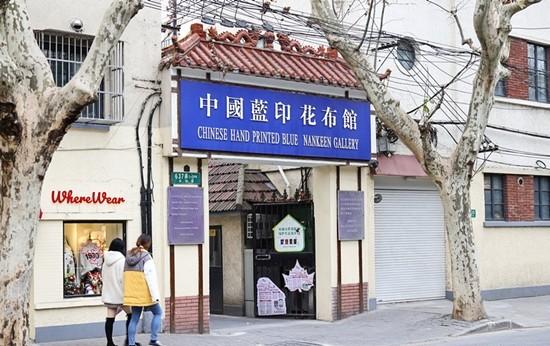
At the entrance of Lane 637, Changle Road, a blue signboard is printed with the words "China Blue Printed Cloth Museum", a two-story old house with a pale yellow wall that has been mottled. Yesterday, on the centenary of the birth of the founder of the "China Blue Printed Cloth Museum" and a Japanese friend, Kubo Asa, a small symposium was held here.
Step into the circular arches and follow the cobbled path into the depths of the alley, where a dazzling array of blue printed cloths will be reflected. Clothing, tablecloths, cushions, satchels... All the products are blue and white floral ornaments, and the changes are endless. The rooms are also decorated with blue printed cloth.
The purpose of the opening of the Blue Printed Cloth Museum was to promote Chinese blue printed cloth, and Kubo Wasa was the adopted daughter of the famous Japanese playwright and Japanese-Chinese friend Kubo Ei. In 1955, Kubo saw the blue seal for the first time at the commodity exhibition held by Chinese foreign trade enterprises in Tokyo. With the normalization of sino-Japanese diplomatic relations in the 1970s and the opening of people-to-people exchanges, Kubo Camea came to China many times, riding in jeeps, tractors or ox carts, going deep into the countryside of some provinces in southern and southwestErn China to collect a variety of blue printed cloth. Her harvest was more than a dozen boxes of blue-printed clothing, sheets, wrapped skins, engraved flower plates on mulberry paper, and even rare clip-on-valerian plates. Finally, she bought a small two-storey bungalow in Shanghai and opened this blue printed cloth museum. In the days that followed, Kubo saw the promotion of blue printed cloth in Japan, the opening of a specialty store in the high-end accommodation area of Tokyo's Freedom Hill to promote blue printed cloth, and the publication of various books such as "Chinese Blue Printed Cloth".
Zhao Lihong, vice chairman of the Shanghai Writers Association and poet, has a deep friendship with Kubo Linen, according to her recollection, in the 1990s, the country did not care about blue printed cloth, and rarely saw relevant traces in urban life, Kubo Linen made more than 200,000 business cards containing blue printed cloth elements, and actively promoted blue printed cloth. "After Kubo was thirty years old, everything she did was working hard for the promotion of blue printed cloth, and no museum in China had more blue printed cloth than her. She collects ancient clothes and wrapped skins of blue printed cloth, the oldest of which is from the Ming and Qing dynasties. "Under the impetus of Kubo linen, blue printed cloth has gradually merged with modern life and become a bit of embellishment. Kubo Asa once said to visitors to the Blue Printed Cloth Museum with Chinese: "My favorite color is blue and white, and the flower cloth dyed with blue indigo gives people a mysterious connotation and style, charming!" ”
She specially asked a lawyer to make a will, and handed over all her investment and collection in the blue printed cloth museum to the relevant departments in Shanghai free of charge, and the only requirement was that the use function of the house should not be changed.
The blue printed cloth hall, hidden deep in the alley, has existed for more than 20 years, and the curator revealed that the inheritor of the blue printed cloth is now 58 years old. "This year marks the tenth anniversary of The death of Kubo Masa, and we should not forget her." Zhao Lihong said. (Xinmin Evening News reporter Xu Yisheng)